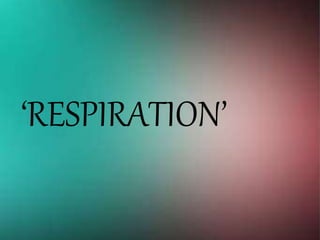Resiration
•Download as PPTX, PDF•
2 likes•76 views
Transport of gases through respiratory membrane.
Report
Share
Report
Share

Recommended
Recommended
More Related Content
What's hot
What's hot (20)
Surfactant & compliance, LAW OF LAPLACE, Work of Breathing (the guyton and ha...

Surfactant & compliance, LAW OF LAPLACE, Work of Breathing (the guyton and ha...
Role of respiratory muscles and various pressures in pulmonary ventilation

Role of respiratory muscles and various pressures in pulmonary ventilation
Respiratory #1, Pulmonary Ventilation - Physiology

Respiratory #1, Pulmonary Ventilation - Physiology
Similar to Resiration
Similar to Resiration (20)
ANATOMY OF THE RESPIRATORY SYSTEM for students.pptx

ANATOMY OF THE RESPIRATORY SYSTEM for students.pptx
Recently uploaded
Xanthomonas axonopodis pv.citri is a bacterium that attacks citrus trees and flourishes in locations with high temperatures, rains and strong winds. In places with these features, X. axonopodis pv.citri produces citrus canker, resulting in significant economic losses for citrus companies. It spreads by the unintentional movement of diseased citrus fruits and seedlings to uninfected areas.Virulence Analysis of Citrus canker caused by Xanthomonas axonopodis pv. citr...

Virulence Analysis of Citrus canker caused by Xanthomonas axonopodis pv. citr...TALAPATI ARUNA CHENNA VYDYANAD
Recently uploaded (20)
Virulence Analysis of Citrus canker caused by Xanthomonas axonopodis pv. citr...

Virulence Analysis of Citrus canker caused by Xanthomonas axonopodis pv. citr...
Soil and Water Conservation Engineering (SWCE) is a specialized field of stud...

Soil and Water Conservation Engineering (SWCE) is a specialized field of stud...
Isolation of AMF by wet sieving and decantation method pptx

Isolation of AMF by wet sieving and decantation method pptx
WASP-69b’s Escaping Envelope Is Confined to a Tail Extending at Least 7 Rp

WASP-69b’s Escaping Envelope Is Confined to a Tail Extending at Least 7 Rp
GBSN - Microbiology (Unit 6) Human and Microbial interaction

GBSN - Microbiology (Unit 6) Human and Microbial interaction
Extensive Pollution of Uranus and Neptune’s Atmospheres by Upsweep of Icy Mat...

Extensive Pollution of Uranus and Neptune’s Atmospheres by Upsweep of Icy Mat...
Biochemistry and Biomolecules - Science - 9th Grade by Slidesgo.pptx

Biochemistry and Biomolecules - Science - 9th Grade by Slidesgo.pptx
Factor Causing low production and physiology of mamary Gland

Factor Causing low production and physiology of mamary Gland
Continuum emission from within the plunging region of black hole discs

Continuum emission from within the plunging region of black hole discs
Alternative method of dissolution in-vitro in-vivo correlation and dissolutio...

Alternative method of dissolution in-vitro in-vivo correlation and dissolutio...
Manganese‐RichSandstonesasanIndicatorofAncientOxic LakeWaterConditionsinGale...

Manganese‐RichSandstonesasanIndicatorofAncientOxic LakeWaterConditionsinGale...
POST TRANSCRIPTIONAL GENE SILENCING-AN INTRODUCTION.pptx

POST TRANSCRIPTIONAL GENE SILENCING-AN INTRODUCTION.pptx
Exomoons & Exorings with the Habitable Worlds Observatory I: On the Detection...

Exomoons & Exorings with the Habitable Worlds Observatory I: On the Detection...
SaffronCrocusGenomicsThessalonikiOnlineMay2024TalkOnline.pptx

SaffronCrocusGenomicsThessalonikiOnlineMay2024TalkOnline.pptx
Resiration
- 2. “TRANSPORT OF GASES THROUGH THE RESPIRATORY MEMBRANE”
- 3. CONTENTS RESPIRATORY UNIT RESPIRATORY MEMBRANE FACTORS EFFECTING RATE OF GAS DIFFUSION DIFFUSION CAPACITY OF MEMBRANE TRANSPORT OF OXYGEN IN ARTERIAL BLOOD CONCLUSION
- 4. RESPIRATORY UNIT Respiratory Unit., which is composed of a respiratory bronchiole, alveolar ducts, atria, and alveoli. There are about 300 million alveoli in the two lungs, and each alveolus has an average diameter of about 0.2 millimeter.
- 6. RESPIRATORY MEMBRANE Gas exchange between the alveolar air and the pulmonary blood occurs through the membranes of all the terminal portions of the lungs, not merely in the alveoli themselves. All these membranes are collectively known as the Respiratory membrane, also called the Pulmonary membrane.
- 7. CROSS SECTIONVIEWOF ALVEOLAR WALLS
- 9. The following different layers of the respiratory membrane: • A layer of fluid lining the alveolus and containing surfactant that reduces the surface tension of the alveolar fluid • The alveolar epithelium composed of thin epithelial cells • An epithelial basement membrane • A thin interstitial space between the alveolar epithelium and the capillary membrane • A capillary basement membrane that in many places fuses with the alveolar epithelial basement membrane • The capillary endothelial membrane
- 10. FACTORS AFFECTING THE RATE OF GAS DIFFUSION The factors that determine how rapidly a gas will pass through the membrane are : The thickness of the membrane, Surface area of the membrane, Diffusion coefficient of the gas in the substance of the membrane, and Partial pressure difference of the gas between the two sides of the membrane.
- 11. DIFFUSION CAPACITY The ability of the respiratory membrane to exchange a gas between the alveoli and the pulmonary blood is expressed in quantitative terms by the respiratory membrane’s diffusing capacity, which is defined as the volume of a gas that will diffuse through the membrane each minute for a partial pressure difference of 1 mmHg. All the factors discussed earlier that affect diffusion through the respiratory membrane can affect diffusing capacity.
- 12. DIFFUSIONCAPACITYOF OXYGEN The average young man, the diffusing capacity for oxygen under resting conditions averages = 21 ml/min/mm Hg. In functional terms it means oxygen pressure difference across the respiratory membrane during normal, quiet breathing is about = 11 mm Hg. Multiplication of this pressure by the diffusing capacity (11 x 21) = 230 milliliters of oxygen diffusingthrough the respiratory membrane each minute; This is equal to the rate at which the resting body uses oxygen.
- 13. 98 % of the blood that enters the left atrium from the lungs has just passed through the alveolar capillaries and has become oxygenated up to a Po2 of about 104 mm Hg. Another 2 % of the blood has passed from the aorta through the bronchial circulation, which supplies mainly the deep tissues of the lungs and is not exposed to lung air.This blood flow is called “shunt flow,” When this blood combines in the pulmonary veins with the oxygenated blood from the alveolar capillaries, this so-called venous admixture of blood causes the Po2 of the blood entering the left heart and pumped into the aorta to fall to about 95 mm Hg. TRANSPORT OF OXYGEN IN ARTERIAL BLOOD
- 14. THANK YOU..
